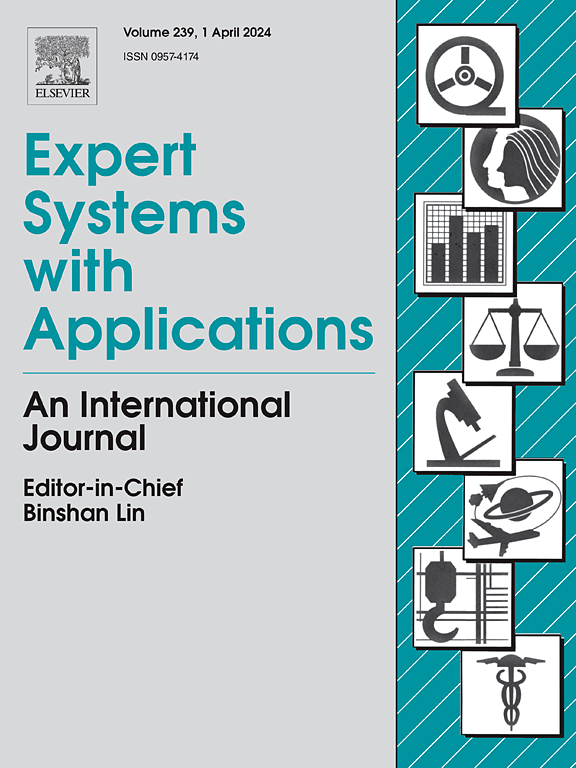Bivariate BMM-based hybrid domain image watermark detector
IF 7.5
1区 计算机科学
Q1 COMPUTER SCIENCE, ARTIFICIAL INTELLIGENCE
引用次数: 0
Abstract
Robustness, imperceptibility, and watermark capacity are three indispensable and contradictory properties for any image watermarking systems. It is a challenging work to achieve the balance among the three important properties. In this paper, by using the bivariate Beta mixture model (Bivariate BMM), we present a statistical image watermark scheme in nonsubsampled Contourlet transform (NSCT)-fractional order Jacobi Fourier moments (FJFMs) amplitude hybrid domain. The whole watermarking algorithm includes two parts: watermark embedding and detection. NSCT is firstly performed on host image to obtain the frequency subbands, and the NSCT subbands are divided into non overlapping blocks. Then, the significant NSCT domain blocks are selected using local binary patterns (LBP). Meanwhile, for each selected NSCT coefficient block, FJFMs are calculated to obtain the NSCT-FJFMs amplitude. Finally, watermark signals are inserted into the amplitude hybrid domain of NSCT-FJFMs. In order to detect accurately watermark signal, the statistical characteristics of NSCT-FJFMs magnitudes are analyzed in detail. Then, NSCT-FJFMs magnitudes are described statistically by Bivariate BMM, which can simultaneously capture the marginal distribution and strong dependencies of NSCT-FJFMs magnitudes. Also, Bivariate BMM parameters are estimated accurately by the rough-enhanced-Bayes mixture estimation & expectation–maximization (REBMIX&EM) approach. Finally, a statistical watermark detector based on the locally optimum (LO) decision rule and Bivariate BMM is developed in NSCT-FJFMs magnitude hybrid domain. Also, the closed-form expressions on the LO statistic is derived and the receiver operating characteristic (ROC) about our detector is analyzed. Extensive experimental results show the superiority of the proposed image watermark detector over some state-of-the-art statistical watermarking methods.
基于双变量 BMM 的混合域图像水印检测器
对于任何图像水印系统来说,鲁棒性、不可感知性和水印容量是三个不可或缺又相互矛盾的特性。如何在这三个重要特性之间取得平衡是一项极具挑战性的工作。本文利用双变量贝塔混合模型(Bivariate Beta mixture model,BMM),在无子采样轮廓变换(NSCT)-分数阶雅各比傅里叶矩(FJFMs)振幅混合域中提出了一种统计图像水印方案。整个水印算法包括两部分:水印嵌入和检测。首先对主图像进行 NSCT 处理,以获得频率子带,并将 NSCT 子带划分为非重叠块。然后,使用局部二进制模式(LBP)选择重要的 NSCT 域块。同时,对于每个选定的 NSCT 系数块,计算 FJFMs 以获得 NSCT-FJFMs 振幅。最后,将水印信号插入 NSCT-FJFMs 的振幅混合域。为了准确检测水印信号,需要详细分析 NSCT-FJFMs 幅值的统计特征。然后,用双变量 BMM 对 NSCT-FJFMs 幅值进行统计描述,它可以同时捕捉 NSCT-FJFMs 幅值的边际分布和强依赖性。此外,通过粗糙增强贝叶斯混合估计&期望最大化(REBMIX&EM)方法,可以准确估计双变量 BMM 参数。最后,在 NSCT-FJFMs 幅值混合域中开发了基于局部最优(LO)决策规则和双变量 BMM 的统计水印检测器。此外,还推导出了 LO 统计的闭式表达式,并分析了检测器的接收器工作特性(ROC)。广泛的实验结果表明,所提出的图像水印检测器优于一些最先进的统计水印方法。
本文章由计算机程序翻译,如有差异,请以英文原文为准。
求助全文
约1分钟内获得全文
求助全文
来源期刊

Expert Systems with Applications
工程技术-工程:电子与电气
CiteScore
13.80
自引率
10.60%
发文量
2045
审稿时长
8.7 months
期刊介绍:
Expert Systems With Applications is an international journal dedicated to the exchange of information on expert and intelligent systems used globally in industry, government, and universities. The journal emphasizes original papers covering the design, development, testing, implementation, and management of these systems, offering practical guidelines. It spans various sectors such as finance, engineering, marketing, law, project management, information management, medicine, and more. The journal also welcomes papers on multi-agent systems, knowledge management, neural networks, knowledge discovery, data mining, and other related areas, excluding applications to military/defense systems.
 求助内容:
求助内容: 应助结果提醒方式:
应助结果提醒方式:


